Blog, Optical Transceiver
What is QSFP & QSFP28 Port? Everything You Need to Know
Estimated reading time: 5 minutes
In the previous blog, we discussed the SFP port. However, with the growing network upgrade and development, more and more high-speed ethernet switches and devices are equipped with a QSFP port or QSFP28 port. So, What are the QSFP and QSFP28 port? As part of our tutorial series, we want to focus on this topic in this post and create a complete guide for beginners.
Now, Let’s dive in.
Table of contents
What is QSFP Port?
Like an SFP port, a QSFP port is a physical cage and connector in a high-speed networking device that accepts only a QSFP form factor module insert. We sometimes refer to it as a QSFP+ port; however, you should know they have the same meaning.
Typically, a QSFP port is the same height as an SFP but has an increased width of approximately 40%. Unlike the SFP port, the QSFP supports four-channel data streams in a single connector. Therefore, it has three times the density of SFP+ interconnects. The QSFP slot typically supports 40Gbps to 56Gbps speed and is widely used in data centers, storage, and servers.
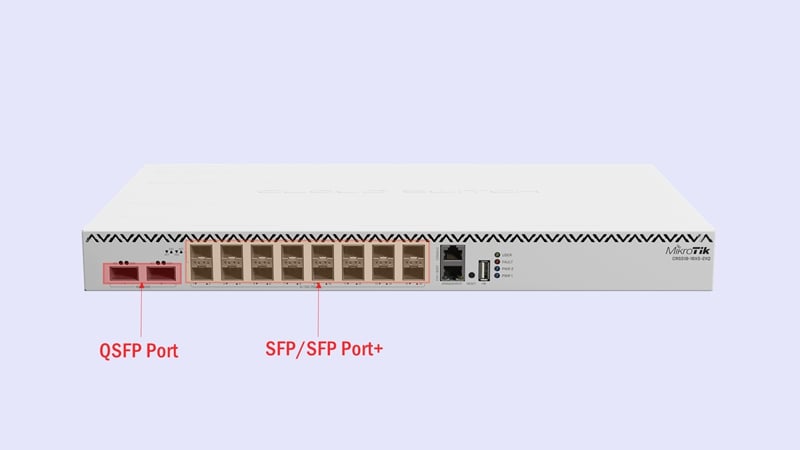
It’s important to note that many manufacturers and users also referred to the QSFP28 as a QSFP port. You may consider these ports the same, especially in terms of physical size; the only difference is data speed. In the later section, we will provide a detailed explanation.
Where is a QSFP port located?
The QSFP port is found in many network devices, such as high-speed Ethernet switches, servers, routers, network interface cards (NIC), Network-Attached Storage (NAS), Firewalls, and GPUs. This equipment may have one or multiple ports based on the different applications.
In most cases, it is located on the front panels of ethernet network switches or the top of network adapters. Sometimes, it may also be situated in switches and NAS’s rear panels. Now, you can check the QSFP location if you have one of these switches.
What is a QSFP port used for?
Simply put, the QSFP connector or port provides a physical house connector that allows the switches to build high-speed connectivity over the QSFP module, DAC, and AOC cable. With one or more QSFP connectors, the switch can support higher-density optical interfaces in limited space.
Compared with SFP+ interconnects, the QSFP increases the port density by around threefold. This is essential for the demand-limiting space of data centers, cloud computing, enterprise networks, and AI clusters. That is why QSFP is becoming increasingly popular; therefore, most modern networking switches have at least one QSFP port.
-
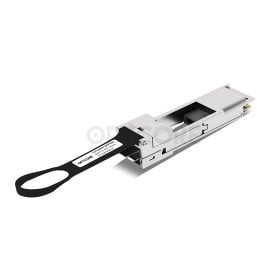 Cisco CVR-QSFP-SFP10G Compatible 40G QSFP+ to 10G SFP+ Adapter Converter Module (QSA Adapter)US$ 53.00 (Excl. VAT)
Cisco CVR-QSFP-SFP10G Compatible 40G QSFP+ to 10G SFP+ Adapter Converter Module (QSA Adapter)US$ 53.00 (Excl. VAT) -
 Generic Compatible 40G QSFP+ ER4 1271~1331nm 40km TransceiverUS$ 359.00 (Excl. VAT)
Generic Compatible 40G QSFP+ ER4 1271~1331nm 40km TransceiverUS$ 359.00 (Excl. VAT) -
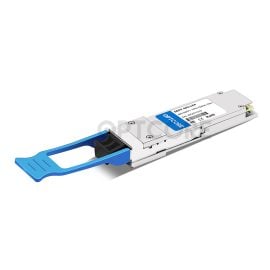 Generic Compatible 40GBASE-LR4 QSFP+ 1310nm 10km TransceiverUS$ 99.00 (Excl. VAT)
Generic Compatible 40GBASE-LR4 QSFP+ 1310nm 10km TransceiverUS$ 99.00 (Excl. VAT) -
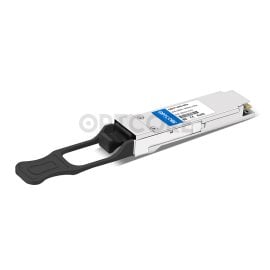 Generic Compatible 40GBASE-SR4 QSFP+ 850nm 100m TransceiverUS$ 24.00 (Excl. VAT)
Generic Compatible 40GBASE-SR4 QSFP+ 850nm 100m TransceiverUS$ 24.00 (Excl. VAT)
What is QSFP28 Port
A QSFP28 port still has the same specific appearance and size as a QSFP 40G port. Therefore, you can not even see any difference just from the appearance. However, the QSFP28 port supports data speeds up to 100G/112G or 4x25Gbps / 4x28Gbps, which makes it different from the general QSFP cage.
Industry vendors and users sometimes mix QSFP and QSFP28 ports. In most cases, whether it’s a QSFP or a QSFP28, they both represent some port on the switch. We need to determine whether it is a QSFP or QSFP28 port in conjunction with the port rate.
What is a QSFP28 port used for?
QSFP28 is not a new product; it is widely used in High-bandwidth data center switches, backbone routers, and storage equipment. As one of the most popular 100G ports, the QSFP28 port has replaced the traditional CFP/CFP2/CFP4, demonstrating extreme competitiveness.
Industry leaders like Cisco and Nvidia have integrated 100G QSFP28 ports into their high-performance switches to meet the needs of modern data-driven environments. These QSFP/QSFP28 ports enable ultra-fast data transfers, making them ideal for applications such as data center interconnects, high-frequency trading platforms, and AI workloads. The ports enhance connectivity among servers, storage systems, and networking equipment by providing significant bandwidth in a compact form factor. This integration facilitates seamless data flow and improves overall enterprise and cloud computing infrastructure efficiency.
-
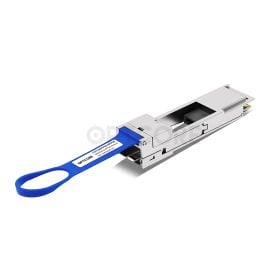 Mellanox MAM1Q00A-QSA28 Compatible 100G QSFP28 to 25G SFP28 Adapter ConverterUS$ 59.00 (Excl. VAT)
Mellanox MAM1Q00A-QSA28 Compatible 100G QSFP28 to 25G SFP28 Adapter ConverterUS$ 59.00 (Excl. VAT) -
 Generic Compatible 100GBASE-ER4 QSFP28 1310nm 40km TransceiverUS$ 799.00 (Excl. VAT)
Generic Compatible 100GBASE-ER4 QSFP28 1310nm 40km TransceiverUS$ 799.00 (Excl. VAT) -
 Generic Compatible 100G QSFP28 LR4 10km TransceiverUS$ 179.00 (Excl. VAT)
Generic Compatible 100G QSFP28 LR4 10km TransceiverUS$ 179.00 (Excl. VAT) -
 Generic Compatible 100G QSFP28 SR4 850nm 100m TransceiverUS$ 32.90 (Excl. VAT)
Generic Compatible 100G QSFP28 SR4 850nm 100m TransceiverUS$ 32.90 (Excl. VAT)
QSFP vs QSFP28 Port: What is the difference?
Although many guys may mix and use those terms, we still make a simple comparison table on QSFP vs QSFP28 port.
| Forms | Standard | Datarate | Channel | Connector | DOM | Size | Price |
| QSFP+ | IEEE 802.3ba QSFP+ MSA SFF-8436 SFF-8636 Infiniband 40G QDR | 40G 56G | 4x10G 4x14G | 38-pin connector | Yes | Same | Medium |
| QSFP28 | IEEE 802.3bm QSFP28 MSA SFF-8665 SFF-8636 | 100G 112G | 4x25G 4x28G | 38-pin connector | Yes | Same | A bit Higher |
FAQ
Q: Can I use the SFP+ module in the QSFP port?
A: The short answer is you can not use SFP+ directly in the QSFP port. However, by inserting a 40G QSFP to SFP+ QSA converter into a QSFP 40G port, you may convert it to a 10G SFP+ port and then use the general SFP+ module.
Q: Can I use the 25G SFP28 module in the QSFP28 port?
A: The SFP28 module cannot be directly plugged into the QSFP28 port because they have different form factors. However, you can use the SFP28 module in the QSFP28 port by using an additional 100 G QSA adapter.
Q: How can I connect the QSFP+ port to the SFP+ port?
A: Connect QSFP to SFP+ port; there are four methods.
-Use QSFP to SFP+ breakout DAC cable
-Use QSFP to SFP+ breakout AOC cable
-Use QSFP and MPO breakout patch cable (for MPO QSFP)
-Use QSA adapter
Q: What is the typical QSFP speed?
A: The typical speed of the QSFP+ port is 40Gbps by default. However, in some special applications, it may also be 56Gbps.
Conclusion
QSFP ports play a vital role in high-speed networks. Without them, we can not even build essential connectivity over optical fibers. In this post, we have introduced the QSFP and QSFP28 ports. Now, can you tell their difference? Do you have any questions?
Let me know by Leaving a message now.
Read more:
- SFP+, SFP28, QSFP+, QSFP28, QSFP56, QSFP-DD, QSFP112 vs OSFP, What are the differences?
- 40G QSFP+ vs. 100G QSFP28 Transceiver: Pros and Cons
- What is SFP Port? Everything You Need to Know
Reference:







